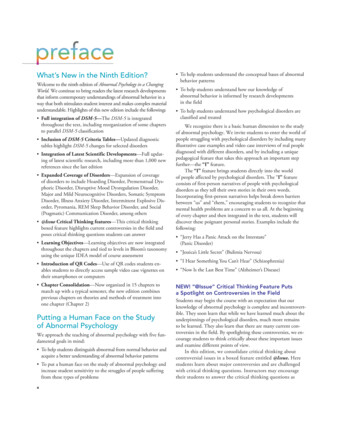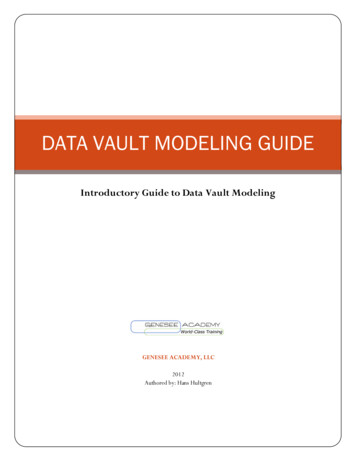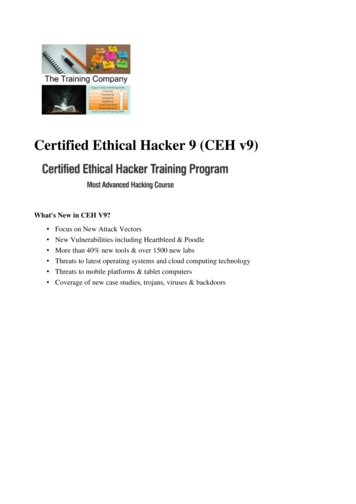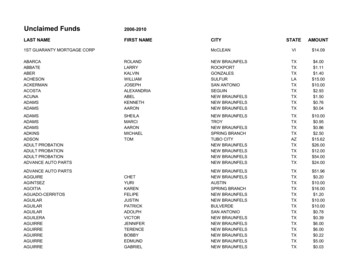
Transcription
What’s New in the Ninth Edition?Welcome to the ninth edition of Abnormal Psychology in a ChangingWorld. We continue to bring readers the latest research developmentsthat inform contemporary understandings of abnormal behavior in away that both stimulates student interest and makes complex materialunderstandable. Highlights of this new edition include the following: Full integration of DSM-5—The DSM-5 is integratedthroughout the text, including reorganization of some chaptersto parallel DSM-5 classification Inclusion of DSM-5 Criteria Tables—Updated diagnostictables highlight DSM-5 changes for selected disorders Integration of Latest Scientific Developments—Full updating of latest scientific research, including more than 1,000 newreferences since the last edition Expanded Coverage of Disorders—Expansion of coverageof disorders to include Hoarding Disorder, Premenstrual Dysphoric Disorder, Disruptive Mood Dysregulation Disorder,Major and Mild Neurocognitive Disorders, Somatic SymptomDisorder, Illness Anxiety Disorder, Intermittent Explosive Disorder, Pyromania, REM Sleep Behavior Disorder, and Social(Pragmatic) Communication Disorder, among others @Issue Critical Thinking features—This critical thinkingboxed feature highlights current controversies in the field andposes critical thinking questions students can answer Learning Objectives—Learning objectives are now integratedthroughout the chapters and tied to levels in Bloom’s taxonomyusing the unique IDEA model of course assessment Introduction of QR Codes—Use of QR codes students enables students to directly access sample video case vignettes ontheir smartphones or computers Chapter Consolidation—Now organized in 15 chapters tomatch up with a typical semester, the new edition combinesprevious chapters on theories and methods of treatment intoone chapter (Chapter 2)Putting a Human Face on the Studyof Abnormal PsychologyWe approach the teaching of abnormal psychology with five fundamental goals in mind: To help students distinguish abnormal from normal behavior andacquire a better understanding of abnormal behavior patterns To put a human face on the study of abnormal psychology andincrease student sensitivity to the struggles of people sufferingfrom these types of problems To help students understand the conceptual bases of abnormalbehavior patterns To help students understand how our knowledge ofabnormal behavior is informed by research developmentsin the field To help students understand how psychological disorders areclassified and treatedWe recognize there is a basic human dimension to the studyof abnormal psychology. We invite students to enter the world ofpeople struggling with psychological disorders by including manyillustrative case examples and video case interviews of real peoplediagnosed with different disorders, and by including a uniquepedagogical feature that takes this approach an important stepfurther—the “I” feature.The “I” feature brings students directly into the worldof people affected by psychological disorders. The “I” featureconsists of first-person narratives of people with psychologicaldisorders as they tell their own stories in their own words. Incorporating first-person narratives helps break down barriersbetween “us” and “them,” encouraging students to recognize thatmental health problems are a concern to us all. At the beginningof every chapter and then integrated in the text, students willdiscover these poignant personal stories. Examples include thefollowing: “Jerry Has a Panic Attack on the Interstate”(Panic Disorder) “Jessica’s Little Secret” (Bulimia Nervosa) “I Hear Something You Can’t Hear” (Schizophrenia) “Now Is the Last Best Time” (Alzheimer’s Disease)NEW! “@Issue” Critical Thinking Feature Putsa Spotlight on Controversies in the FieldStudents may begin the course with an expectation that ourknowledge of abnormal psychology is complete and incontrovertible. They soon learn that while we have learned much about theunderpinnings of psychological disorders, much more remainsto be learned. They also learn that there are many current controversies in the field. By spotlighting these controversies, we encourage students to think critically about these important issuesand examine different points of view.In this edition, we consolidate critical thinking about controversial issues in a boxed feature entitled @Issue. Here students learn about major controversies and are challengedwith critical thinking questions. Instructors may encouragetheir students to answer the critical thinking questions asxA01 NEVI1719 09 SE FM.indd 106/10/13 5:24 PM
required or elective writing assignments. Examples include thefollowing: Should Therapists Treat Clients Online? What Accounts for the Gender Gap in Depression? Should We Use Drugs to Treat Drug Abuse? Is Mental Illness a Myth?Two of the @Issue features in this edition are written byoutside contributors who are leading authorities in the field: Dr.Thomas Widiger of the University of Kentucky (“The DSM :The Bible of Psychiatry”); and Dr. Jerry Deffenbacher of Colorado State University (“Anger Disorders and the DSM: WhereHas All the Anger Gone?”).NEW! Interactive Concept Maps in Abnormal Psychology: A Unique Visual Learning ToolConcept Maps in Abnormal Psychology are unique visual learning diagrams crafted to help students visualize linkages betweenspecific disorders, underlying causal factors, and treatment approaches. Students learn best when they are actively engaged inthe learning process. To engage students in active learning, weconverted the Concept Maps in this edition to an interactive,online format hosted on MyPsychLab. The maps are presentedin a fill-in-the-blanks format in which key words and terms areomitted so that students can fill in the missing pieces to completethese knowledge structures. The completed maps may be used asan active study tool or submitted to instructors as required courseassignments or extra credit assignments.Keeping Pace with an Ever-Changing FieldThe text integrates the latest research findings and scientific developments in the field that inform our understanding of abnormal psychology. We present these research findings in a way thatmakes complex material engaging and accessible to the student.Focus on NeuroscienceAs part of our continuing efforts to integrate important advances inneuroscience that inform our understanding of abnormal behaviorpatterns, we have built upon the very solid foundations in previouseditions to include new material from neuroscience research throughout the text. Students will read about the search for endophenotypesin schizophrenia, the emerging field of epigenetics, use of brain scansto diagnose psychological disorders, efforts to probe the workings ofthe meditative brain, potential use of drugs to enhance effectiveness ofexposure therapy, and emerging research exploring whether disturbing memories linked to PTSD might be erased.The Fully Integrated TextbookIntegrating the DSM-5After years of development and debate, the DSM-5 is finallyhere. The ninth edition of the text is fully integrated with theDSM-5. Instructors are challenged to revise their instructionalmaterials in light of the many changes introduced in the DSM-5.We integrated the DSM-5 throughout the text to allow a seamless transition in teaching abnormal psychology. We apply DSM-5 criteria in the body of the text and in the many accompanying overview charts throughout the text. Although werecognize the importance of the DSM system in the c lassificationof psychological or mental disorders, we believe a course in abnormal psychology should not be taught as a training coursein the DSM or as a psychodiagnostic seminar. We also recognizethe many limitations of the DSM system, even in its latestversion.Integrating DiversityWe examine abnormal behavior patterns in relation to factorsof diversity such as ethnicity, culture, gender, sexual orientation, and socioeconomic status. We believe students need tounderstand how issues of diversity affect the conceptualizationof abnormal behavior as well as the diagnosis and treatment ofpsychological disorders. We also believe that coverage of diversity should be integrated directly in the text, not separated off inboxed features.Integrating Theoretical PerspectivesStudents often feel as though one theoretical perspective must ultimately be right and all the others wrong. We examine the manydifferent theoretical perspectives that inform contemporary understanding of abnormal psychology and help students integratethese diverse viewpoints in the Tying It Together feature. Wealso explore potential causal pathways involving interactions ofpsychological, sociocultural, and biological factors. We hope toimpress upon students the importance of taking a broader viewof the complex problems we address by considering the influences of multiple factors and their interactions.NEW! Integrating Video Case Exampleswith Student-Enabled QR CodesVideo case examples provide students with opportunities to seeand hear individuals who are diagnosed with different types ofpsychological disorders. Students can read about the clinicalfeatures of specific disorders and, with a few clicks of a computer mouse, see a video case example that illustrates conceptsdiscussed in the text. The video case examples are highlighted inthe margins of the text with an icon and can be accessed throughMyPsychLab at www.mypsychlab.com. We also introduce student-enabled fast response or QR codes that allow students todirectly access the first video case in a chapter for display on theirsmartphones or personal computers.The video case examples supplement the many illustrativecase examples included in the text itself. Putting a human face onthe subject matter helps make complex material more accessible.Many of these case examples are drawn from our own clinicalfiles and those of leading mental health professionals.PREFACE xiA01 NEVI1719 09 SE FM.indd 116/10/13 5:24 PM
Integrating Critical ThinkingWe encourage students to think more deeply about key conceptsin abnormal psychology by including two sets of critical thinkingitems in each chapter. First, the @Issue feature highlights currentcontroversies in the field and includes critical thinking questionsthat challenge students to think further about the issues discussedin the text. Second, the critical thinking questions at the end ofeach chapter challenge students to think carefully and criticallyabout concepts discussed in the chapter and to reflect on howthese concepts relate to their own experiences or experiences ofpeople they know. To integrate writing-across-the-curriculum(WAC) objectives, instructors may wish to assign the criticalthinking questions in the @Issue features and the critical thinkingquestions at the end of each chapter as required or extra-creditwriting assignments.psychological knowledge (or analyzing and evaluating domains asrepresented in the revised taxonomy). By building exams aroundthese learning objectives, instructors can assess not only overallstudent knowledge, but also acquisition of skills at different levelsof cognitive complexity in Bloom’s taxonomy.NEW! Integrating Learning Objectiveswith Bloom’s TaxonomyThis edition introduces learning objectives at the start of eachchapter. The learning objectives in this text are integrated withthe IDEA model of course assessment, which comprise four keyacquired skills in the study of abnormal psychology that spell outthe convenient acronym, IDEA:Focus on the Interactionist ApproachWe approached our writing with the belief that a better understanding of abnormal psychology is gained by adopting abiopsychosocial orientation that takes into account the rolesof psychological, biological, and sociocultural factors and theirinteractions in the development of abnormal behavior patterns.We emphasize the value of taking an interactionist approach asa running theme throughout the text. We highlight a prominentinteractionist model, the diathesis–stress model, to help studentsbetter understand the factors contributing to different forms ofabnormal behavior.Identify criteria used to determine whether behavior isabnormal, categories of psychotropic or psychiatric drugs,specific types of disorders within diagnostic categories, riskfactors for suicide among adolescents, etc.2. Define or Describe key features of different psychological disorders and theoretical understandings, etc.3. Explain or Evaluate major perspectives on abnormalpsychology, effectiveness of psychotherapy, how cocaineaffects the brain, etc.4. Apply key features of critical thinking, knowledge ofhealthy sleeping habits, the diathesis-stress model to thedevelopment of schizophrenia, etc.1.The IDEA model is integrated with the widely used taxonomy of educational objectives developed by the renownededucational researcher Benjamin Bloom. Bloom’s taxonomy isarranged in increasing levels of cognitive complexity. The lowestlevels comprise basic knowledge and understanding. The middlelevel involves application of knowledge and the upper levels involve higher level skills of analysis, synthesis, and evaluation.The learning objectives identified in the IDEA model represent three basic levels of cognitive skills in Bloom’s taxonomy.Identify, Describe, and Define learning objectives represent basiclevels of cognitive skills (i.e., knowledge and comprehension inthe original Bloom taxonomy, or remembering and understanding in the revised Bloom taxonomy). The Apply learning objective reflects an intermediate level of cognitive skills involvedin application of psychological concepts. Evaluate and Explainlearning objectives assess more complex, higher-order skills inthe hierarchy involving analysis, synthesis, and evaluation ofMaintaining Our FocusAbnormal Psychology in a Changing World is a complete learningand teaching package that brings into focus four major objectives: (1) integrating an interactionist or biopsychosocial modelof abnormal behavior, (2) underscoring the importance of issuesof diversity to the understanding and treatment of psychologicaldisorders, (3) maintaining currency, and (4) adopting a studentcentric pedagogy.Focus on Exploring Key Issuesin Our Changing WorldThe A Closer Look feature provides opportunities for further exploration of selected topics that reflect cutting-edge issues in thefield. A number of the A Closer Look features focus on advancesin neuroscience research.Focus on Student-Centric PedagogyWe continually examine our pedagogical approach to find evenbetter ways of helping students succeed in this course. To fosterdeeper understanding, we include many pedagogical aids, suchas Truth or Fiction chapter openers to capture student attention and interest, self-scoring questionnaires to encourage activelearning through self-examination, and overview charts, whichare capsulized summaries of disorders that students can use asstudy charts.“Truth or Fiction” Chapter OpenersEach chapter begins with a set of Truth or Fiction questionsto whet the student’s appetite for the subject matter within thechapter. Some items challenge preconceived ideas and commonfolklore and debunk myths and misconceptions, whereas othershighlight new research developments in the field. Instructors andstudents have repeatedly reported to us that they find this featurestimulating and challenging.xii PREFACEA01 NEVI1719 09 SE FM.indd 126/10/13 5:24 PM
The Truth or Fiction questions are revisited and answeredin the sections of the chapter where the topics are discussed. Students are thus given feedback concerning the accuracy of theirpreconceptions in light of the material being addressed.Self-Scoring QuestionnairesThese questionnaires on various topics involve students in thediscussion at hand and encourage them to evaluate their ownattitudes and behavior patterns. In some cases, students may become more aware of troubling concerns, such as states of depression or problems with drug or alcohol use, which they may wantto bring to the attention of a helping professional. We have carefully developed and screened the questionnaires to ensure theywill provide students with useful information to reflect on as wellas serve as a springboard for class discussion.Overview ChartsThese visually appealing overview charts provide summaries ofvarious disorders. We are gratified by the many comments fromstudents and professors regarding the value of these “at-a-glance”study charts.“Summing Up” Chapter SummariesSumming Up chapter summaries provide brief answers to thelearning objectives posed at the beginning of the chapter. Thesesummaries provide students with feedback they can use to compare their own answers to those provided in the text.AncillariesNo matter how comprehensive a textbook is, today’s instructorsand students require a complete teaching package to advanceteaching and comprehension. Abnormal Psychology in a ChangingWorld is accompanied by the following ancillaries:MyPsychLab for Abnormal PsychologyMyPsychLab is an online homework, tutorial, and assessmentprogram that truly engages students in learning. It helps studentsbetter prepare for class, quizzes, and exams—resulting in betterperformance in the course. It provides educators a dynamic set oftools for gauging individual and class performance. To order theninth edition with MyPsychLab, use ISBN 0205965016.Speaking Out: Interviews with People Who Strugglewith Psychological DisordersThis set of video segments allows students to see firsthand accounts of patients with various disorders. The interviewswere conducted by licensed clinicians and range in length from8 to 25 minutes. Disorders include major depressive disorder, obsessive-compulsive disorder, anorexia nervosa, PTSD, alcoholism, schizophrenia, autism, ADHD, bipolar disorder, social phobia, hypochondriasis, borderline personality disorder, andadjustment to physical illness. These video segments are availableon DVD or through MyPsychLab.Volume 1: ISBN 0-13-193332-9Volume 2: ISBN 0-13-600303-6Volume 3: ISBN 0-13-230891-6Instructor’s Manual (020597189X)A comprehensive tool for class preparation and management,each chapter includes learning objectives, a chapter outline, lecture and discussion suggestions, “think about it” discussion questions, activities and demonstrations, suggested video resources,and a sample syllabus. Available for download on the Instructor’sResource Center at www.pearsonhighered.com.Test Bank (0205971881)The Test Bank has been rigorously developed, reviewed, andchecked for accuracy, to ensure the quality of both the questions andthe answers. It includes fully referenced multiple-choice, true/false,and concise essay questions. Each question is accompanied by a pagereference, difficulty level, skill type (factual, conceptual, or applied),topic, and a correct answer. Available for download on the Instructor’s Resource Center at www.pearsonhighered.com.MyTest (020597838X)A powerful assessment-generation program that helps instructorseasily create and print quizzes and exams. Questions and tests canbe authored online, allowing instructors ultimate flexibility and theability to efficiently manage assessments anytime, anywhere. Instructors can easily access existing questions and edit, create, and storequestions using a simple drag-and-drop technique and word-likecontrols. Data on each question provide information on difficultylevel and the page number of corresponding text discussion. Formore information, go to www.PearsonMyTest.com.Lecture PowerPoint Slides (ISBN 0205979610)The PowerPoint slides provide an active format for presenting concepts from each chapter and feature relevant figures andtables from the text. Available for download on the Instructor’sResource Center at www.pearsonhighered.com.Enhanced Lecture PowerPoint Slides with Embedded Videos(ISBN 0205997430)The lecture PowerPoint slides have been embedded with selectSpeaking Out video pertaining to each disorder chapter, enablinginstructors to show videos within the context of their lecture. Nointernet connection is required to play videos.PowerPoint Slides for Photos, Figures, and Tables(ISBN 0205979629)Contain only the photos, figures, and line art from the textbook.Available for download on the Instructor’s Resource Center atwww.pearsonhighered.com.PREFACE xiiiA01 NEVI1719 09 SE FM.indd 136/10/13 5:24 PM
CourseSmart (ISBN 0205968368)CourseSmart Textbooks Online is an exciting choice for studentslooking to save money. As an alternative to purchasing the printtextbook, students can subscribe to the same content online andsave up to 60 percent off the suggested list price of the print text.With a CourseSmart eTextbook, students can search the text,make notes online, print out reading assignments that incorporate lecture notes, and bookmark important passages for laterreview. For more information or to subscribe to the CourseSmarteTextbook, visit www.coursesmart.com.AcknowledgmentsWith each new edition, we try to capture a moving target, asthe literature base that informs our understanding continues to expand. We are deeply indebted to the thousands of talentedscholars and investigators whose work has enriched our understanding of abnormal psychology. Thanks to our colleagues who reviewed our manuscript through earlier editionsand continue to help us refine and strengthen our presentationof this material:Reviewers of the Previous EditionsLaurie Berkshire, Erie Community CollegeSally Bing, University of Maryland Eastern ShoreChristiane Brems, University of Alaska AnchorageWanda Briggs, Winthrop UniversityJoshua Broman-Fulks, Appalachian State UniversityBarbara L. Brown, Georgia Perimeter CollegeAnn Butzin, Owens State Community CollegeGerardo Canul, UC IrvineDennis Cash, Trident Technical CollegeLorry Cology, Owens Community CollegeMichael Connor, California State UniversityCharles Cummings, Asheville-Buncombe TechnicalCommunity CollegeNancy T. Dassoff, University of Illinois—ChicagoDavid Dooley, University of California at IrvineKristina Faimon, Southeast Community College—Lincoln CampusJeannine Feldman, San Diego State UniversityHeinz Fischer, Long Beach City CollegeJohn H. Forthman, Vermillin Community CollegePam Gibson, James Madison UniversityColleen Gift, Blackhawk Technical CollegeKarla J. Gingerich, Colorado State UniversityBernard Gorman, Nassau Community CollegeGary Greenberg, Connecticut CollegeNora Lynn Gussman, Forsyth Technical Community CollegeJohn K. Hall, University of PittsburghMarc Henley, Delaware County Community CollegeJennifer Hicks, Southeastern Oklahoma State UniversityBob Hill, Appalachian State UniversityKristine Jacquin, Mississippi State UniversityRuth Ann Johnson, Augustana CollegeRobert Kapche, California State University at Los AngelesStuart Keeley, Bowling Green State UniversityCynthia Diane Kreutzer, Georgia Perimeter CollegeJennifer Langhinrichsen-Rohling, University of South AlabamaMarvin Lee, Tennessee State UniversityJohn Lloyd, California State University, FresnoDon Lucas, Northwest Vista CollegeTom Marsh, Pitt Community CollegeSara Martino, Richard Stockton College of New JerseyShay McCordick, San Diego State UniversityDonna Marie McElroy, Atlantic Cape Community CollegeLillian McMaster, Hudson County Community CollegeMindy Mechanic, California State University, FullertonLinda L. Morrison, University of New EnglandC. Michael Nina, William Paterson UniversityGary Noll, University of Illinois at ChicagoMartin M. Oper, Erie Community CollegeJoseph J. Palladino, University of Southern IndianaCarol Pandey, L. A. Pierce CollegeRamona Parish, Guilford Technical Community CollegeJackie Robinson, Florida A&M UniversityEsther D. Rosenblum, University of VermontSandra Sego, American International CollegeHarold Siegel, Nassau Community CollegeNancy Simpson, Trident Technical CollegeAri Solomon,Williams CollegeRobert Sommer, University of California—DavisLinda Sonna, University of New Mexico, TaosCharles Spirrison, Mississippi State UniversityStephanie Stein, Central Washington UniversityJoanne Hoven Stohs, California State University—FullertonLarry Stout, Nicholls State UniversityTamara Sullivan, SUNY BrockportDeborah Thomas, Washington State Community CollegeAmber Vesotski, Alpena Community CollegeTheresa Wadkins, University of Nebraska—KearnyNaomi Wagner, San Jose State UniversitySterling Watson, Chicago State UniversityThomas Weatherly, Georgia Perimeter CollegeMax Zwanziger, Central Washington Universityxiv PREFACEA01 NEVI1719 09 SE FM.indd 146/10/13 5:24 PM
We also wish to recognize the exemplary contributions of thepublishing professionals at Pearson who helped guide the development of this edition, especially Erin Mitchell, executive editor,who has brought a distinctive vision to enrich the text and make itan even more effective learning platform; Amber Mackay, associate editor, for beautifully coordinating the many editorial featuresthat comprise this work; production editor Lindsay Bethoney forso skillfully bringing together the various components of the text;and photo editor Kate Cebik, who worked tirelessly to find justthe right images to illustrate key concepts.We especially wish to thank the two people without whoseinspiration and support this effort never would have materializedor been completed: Judith Wolf-Nevid and Lois Fichner-Rathus.We invite students and instructors to contact us at the followingemail address with any comments, suggestions, and feedback.We’d love to hear from you.— J.S.NNew York, New Yorkjeffnevid@gmail.com— S.A.R.New York, New Yorksrathus@aol.com— B.A.GBrooklyn, New YorkPREFACE xvA01 NEVI1719 09 SE FM.indd 156/10/13 5:24 PM
The ninth edition of the text is fully integrated with the DSM-5. Instructors are challenged to revise their instructional materials in light of the many changes introduced in the DSM-5. We integrated the DSM-5 throughout the text to allow a seam-less transition i











